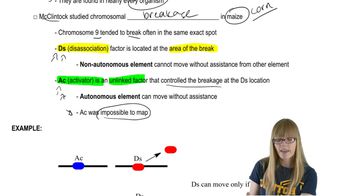Table of contents
- 1. Introduction to Genetics51m
- 2. Mendel's Laws of Inheritance3h 37m
- 3. Extensions to Mendelian Inheritance2h 41m
- 4. Genetic Mapping and Linkage2h 28m
- 5. Genetics of Bacteria and Viruses1h 21m
- 6. Chromosomal Variation1h 48m
- 7. DNA and Chromosome Structure56m
- 8. DNA Replication1h 10m
- 9. Mitosis and Meiosis1h 34m
- 10. Transcription1h 0m
- 11. Translation58m
- 12. Gene Regulation in Prokaryotes1h 19m
- 13. Gene Regulation in Eukaryotes44m
- 14. Genetic Control of Development44m
- 15. Genomes and Genomics1h 50m
- 16. Transposable Elements47m
- 17. Mutation, Repair, and Recombination1h 6m
- 18. Molecular Genetic Tools19m
- 19. Cancer Genetics29m
- 20. Quantitative Genetics1h 26m
- 21. Population Genetics50m
- 22. Evolutionary Genetics29m
13. Gene Regulation in Eukaryotes
GAL Regulation
Problem 21
Textbook Question
A modification of the two-hybrid system, called the one-hybrid system, is used for identifying proteins that can bind specific DNA sequences. In this method, the DNA sequence to be tested, the bait, is fused to a TATA box to drive expression of a reporter gene. The reporter gene is often chosen to complement a mutant phenotype; for example, a HIS gene may be used in a his⁻ mutant yeast strain. A cDNA library is constructed with the cDNA sequences translationally fused to the GAL4 activation domain and transformed into this yeast strain. Diagram how trans-acting proteins that bind to cis-acting regulatory sequences can be identified using a one-hybrid screen.
 Verified step by step guidance
Verified step by step guidance1
Start by understanding the components of the one-hybrid system: the bait DNA sequence, the TATA box, the reporter gene, and the cDNA library fused to the GAL4 activation domain.
Diagram the setup: Place the bait DNA sequence upstream of the TATA box, which is linked to the reporter gene. This setup is integrated into the yeast genome.
Introduce the cDNA library: Each cDNA is fused to the GAL4 activation domain, creating a library of potential DNA-binding proteins.
Transform the yeast strain with the cDNA library: Each yeast cell receives a different cDNA-GAL4 fusion, allowing for the expression of various potential DNA-binding proteins.
Identify successful interactions: If a cDNA-encoded protein binds to the bait DNA sequence, the GAL4 activation domain will activate transcription of the reporter gene, allowing for selection based on the reporter gene's phenotype.
Recommended similar problem, with video answer:
 Verified Solution
Verified SolutionThis video solution was recommended by our tutors as helpful for the problem above
Video duration:
2mPlay a video:
Was this helpful?
Key Concepts
Here are the essential concepts you must grasp in order to answer the question correctly.
One-Hybrid System
The one-hybrid system is a molecular biology technique used to identify proteins that bind to specific DNA sequences. It involves fusing a DNA sequence of interest (the bait) to a promoter, such as a TATA box, which drives the expression of a reporter gene. This system allows researchers to detect interactions between trans-acting proteins and cis-acting regulatory elements, facilitating the study of gene regulation.
Recommended video:
Guided course

Functional Genomics
Cis-acting and Trans-acting Elements
Cis-acting elements are DNA sequences located near a gene that regulate its expression, while trans-acting elements are proteins that bind to these sequences to influence gene activity. In the context of the one-hybrid system, the bait represents a cis-acting element, and the proteins from the cDNA library act as trans-acting factors that can bind to the bait, enabling the identification of specific protein-DNA interactions.
Recommended video:
Guided course

Discovery
Reporter Gene
A reporter gene is a gene that encodes a protein easily measurable or observable, used to indicate whether a specific biological process has occurred. In the one-hybrid system, the reporter gene is linked to the bait DNA sequence, and its expression indicates successful binding of trans-acting proteins to the cis-acting elements. Common reporter genes include those encoding enzymes like HIS3, which can complement mutant phenotypes in yeast, allowing for straightforward detection of interactions.
Recommended video:
Guided course

Mapping Genes

 3:55m
3:55mWatch next
Master GAL Regulation with a bite sized video explanation from Kylia Goodner
Start learningRelated Videos
Related Practice


